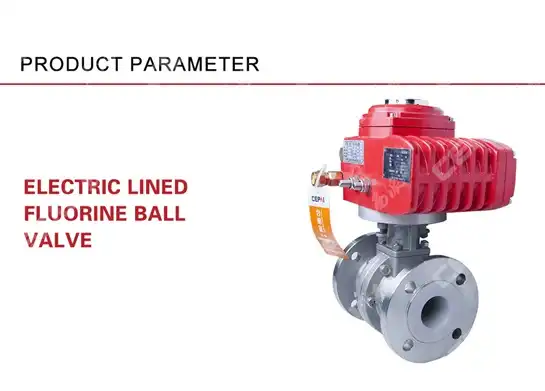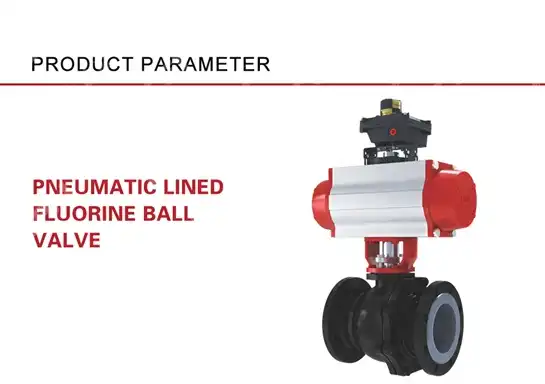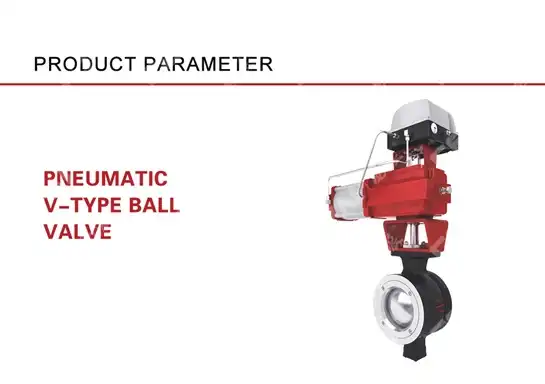How Does a Pneumatic Ball Valve Work?
Imagine your production line suddenly experiencing uncontrolled fluid flow, leading to costly downtime and safety hazards. This nightmare scenario is exactly why understanding pneumatic ball valve operation is critical for industrial operations. A Pneumatic Ball Valve is an automated valve system that uses compressed air or gas to actuate an internal rotating ball, providing precise and rapid control over fluid flow through quarter-turn operation. This article demystifies the working mechanism of pneumatic ball valves, explores their components, applications, and advantages, helping you make informed decisions for your fluid control needs while ensuring operational safety and efficiency in demanding industrial environments.
What Is a Pneumatic Ball Valve and Its Core Components?
-
Understanding Pneumatic Ball Valve Construction
A Pneumatic Ball Valve represents the integration of mechanical valve design with pneumatic automation technology. The system consists of two primary assemblies: the valve body containing the spherical closure element and the pneumatic actuator that provides the motive force. The valve body typically features a hollow, perforated ball element housed between upstream and downstream seats. When the ball rotates ninety degrees, the bore aligns with the pipeline for full flow or perpendicular to it for complete shutoff. This quarter-turn design enables rapid response times, making pneumatic actuated ball valves ideal for applications requiring quick isolation or emergency shutdown capabilities. The valve body construction utilizes high-strength, corrosion-resistant materials to withstand harsh operating conditions across petrochemical, power generation, and water treatment facilities.

-
Pneumatic Actuator Technology and Functionality
The pneumatic actuator converts compressed air energy into rotary mechanical motion necessary for ball valve operation. Modern Pneumatic Ball Valve actuators employ either single-acting or double-acting configurations. Single-acting actuators use compressed air pressure in one direction with spring return for fail-safe positioning, while double-acting actuators utilize air pressure for both opening and closing movements, providing more precise control and greater torque capacity. The actuator housing contains pistons, racks, and pinion gears that translate linear piston motion into the required ninety-degree rotational movement. Advanced designs incorporate position feedback sensors, manual override mechanisms, and adjustable speed controls to enhance operational flexibility. The pneumatic system's inherent speed advantage allows switching times as rapid as 0.05 seconds, significantly faster than manual or electric alternatives, making these valves essential for time-critical process control applications.
-
Critical Sealing and Support Systems
The sealing mechanism within a Pneumatic Ball Valve determines its reliability and longevity under operational stress. Floating ball designs allow the ball element to move slightly downstream under pressure, ensuring tight contact with the downstream seat for effective sealing in low to moderate pressure applications. Trunnion-mounted configurations anchor the ball with upper and lower support shafts, distributing mechanical loads more effectively for high-pressure, large-diameter installations. Seat materials range from resilient polymers like PTFE for general service to metal-seated designs for extreme temperature or abrasive media applications. The valve stem connection to the actuator incorporates anti-blowout features and additional packing arrangements to prevent fugitive emissions. These sealing systems work in concert with the pneumatic actuator to maintain process integrity across millions of operational cycles while meeting increasingly stringent environmental and safety regulations governing industrial valve applications.
How Does the Pneumatic Ball Valve Operating Mechanism Function?
-
Compressed Air Control and Actuation Process
The operational sequence of a Pneumatic Ball Valve begins when compressed air enters the actuator chamber through control solenoid valves or positioners. In a double-acting configuration, air pressure applied to one side of the piston assembly creates differential force that drives the piston linearly. This linear motion engages the rack and pinion mechanism, converting straight-line movement into rotational torque applied to the valve stem. The stem rotates the ball element precisely ninety degrees between fully open and fully closed positions. Air pressure magnitude, typically ranging from 40 to 120 PSI, determines the available actuating force and response speed. Control systems regulate air supply timing and pressure levels to achieve desired valve positioning, whether full on-off operation or modulating control at intermediate positions. The pneumatic medium's compressibility provides inherent cushioning that reduces mechanical shock during rapid actuation cycles, extending component service life while maintaining tight shutoff performance throughout the valve's operational envelope.
-
Flow Control and Shutoff Capabilities
When the Pneumatic Ball Valve is in the open position, the ball's through-bore aligns precisely with the pipeline, creating a straight-through flow path with minimal pressure drop and turbulence. This full-port design characteristic enables unrestricted fluid passage and reduces energy losses compared to globe or gate valve alternatives. As the pneumatic actuator rotates the ball toward the closed position, the solid exterior surface progressively restricts flow area, creating a throttling effect in applications requiring flow modulation. Complete ninety-degree rotation brings the solid ball surface perpendicular to flow direction, where it seats firmly against both upstream and downstream sealing surfaces simultaneously. This dual-direction sealing capability provides bubble-tight shutoff, meeting stringent leakage classifications defined by industry standards. The rapid actuation speed inherent in pneumatic systems enables these valves to serve as emergency isolation devices, quickly stopping flow in response to process upsets or safety system signals, protecting equipment and personnel from potentially hazardous conditions.
-
Fail-Safe and Position Feedback Systems
Advanced Pneumatic Ball Valve installations incorporate fail-safe functionality through spring-return actuator designs that automatically position valves to predetermined safe states upon air supply loss. Single-acting actuators utilize compressed spring energy to drive the valve closed or open, depending on process safety requirements, when pneumatic power fails. This passive safety feature requires no external power or control signals, providing reliable fail-safe action even during facility-wide power outages. Position monitoring systems employ mechanical switches, proximity sensors, or analog positioners that continuously track valve position and communicate status to distributed control systems. These feedback devices verify proper valve response to control commands, detect partial stroking or sticking conditions, and enable predictive maintenance strategies. Intelligent positioners can also implement partial stroke testing protocols that periodically verify valve mobility without disrupting normal process operations, ensuring emergency shutdown capability remains intact throughout extended service intervals between scheduled maintenance activities.
What Are the Key Applications and Advantages of Pneumatic Ball Valves?
-
Industrial Sector Applications and Use Cases
Pneumatic Ball Valve technology serves critical functions across diverse industrial sectors where rapid, reliable flow control is essential. In petrochemical facilities, these valves handle hydrocarbon processing streams, providing emergency isolation capability that protects personnel and assets during upset conditions. Oil and gas production operations deploy pneumatic actuated ball valves at wellheads and gathering systems where remote locations make pneumatic power more practical than electrical supplies. Power generation plants utilize these valves for boiler feedwater control, turbine protection systems, and cooling water management where millisecond response times prevent equipment damage. Water and wastewater treatment facilities employ Pneumatic Ball Valve systems for automated process sequencing, chemical dosing control, and emergency containment functions. The valve's inherent simplicity, combined with pneumatic actuation speed, makes it the preferred choice for applications demanding fail-safe operation, explosion-proof installations, or environments where electrical power availability is limited or hazardous area classifications prohibit electric actuators.
-
Performance Benefits and Operational Advantages
The integration of ball valve design with pneumatic actuation delivers multiple performance advantages that justify its widespread adoption. Rapid actuation speed enables response times measured in fractions of seconds, providing immediate process control or emergency shutdown capability that slower actuator technologies cannot match. The quarter-turn operating principle minimizes wear on sealing surfaces compared to multi-turn valves, extending service intervals and reducing maintenance costs. Pneumatic Ball Valve systems operate reliably across extreme ambient temperature ranges from arctic conditions to desert environments because compressed air functionality remains unaffected by temperature extremes that would compromise hydraulic fluids or electric motor performance. The inherently explosion-proof nature of pneumatic power eliminates ignition sources in hazardous atmospheres, simplifying compliance with safety regulations governing refineries, chemical plants, and other potentially explosive environments. Low maintenance requirements result from the valve's simple mechanical design and the clean, dry instrument air used for actuation, which contains no contaminants that could foul internal components or degrade sealing materials.
-
Quality Assurance and Reliability Considerations
Ensuring Pneumatic Ball Valve reliability requires rigorous quality control throughout the manufacturing process and proper selection for specific application requirements. Reputable manufacturers implement comprehensive testing protocols including dimensional verification, material analysis, pressure testing, and seat leakage validation before product shipment. Certification to international standards such as API 6D, API 6A, ISO 9001, and industry-specific safety integrity level classifications provides documented evidence of quality and performance capability. High-precision manufacturing equipment and advanced inspection technologies ensure dimensional accuracy and surface finish quality that directly impact sealing performance and operational longevity. The valve body and internal components must be manufactured from materials compatible with process media, operating pressures, and temperature conditions to prevent premature failure from corrosion, erosion, or thermal degradation. Proper actuator sizing calculations account for required torque at maximum differential pressure conditions, ensuring reliable operation throughout the specified service envelope while incorporating appropriate safety factors for long-term reliability under actual field conditions.

How to Select and Maintain Pneumatic Ball Valves for Optimal Performance?
-
Selection Criteria and Specification Requirements
Selecting the appropriate Pneumatic Ball Valve for specific applications requires systematic evaluation of multiple technical parameters. Pressure rating must accommodate maximum system pressure with adequate safety margin, considering both static pressure and transient conditions like water hammer. Temperature range considerations encompass both process media temperature and ambient conditions affecting actuator components. Flow capacity calculations determine required valve size to minimize pressure drop while avoiding oversizing that increases cost and actuation torque requirements. Media compatibility analysis ensures valve body materials, sealing elements, and internal coatings resist corrosion, erosion, and chemical attack from the specific fluids or gases being controlled. Actuation speed requirements influence actuator selection between standard and high-cycle designs capable of millions of operations without refurbishment. Control system integration needs determine whether simple on-off solenoid control suffices or if analog positioners with feedback capability are necessary for modulating service. Hazardous area classifications may mandate explosion-proof actuator housings and limit available control signal types to intrinsically safe designs appropriate for the installation environment.
-
Installation Best Practices and Commissioning Procedures
Proper Pneumatic Ball Valve installation significantly impacts long-term performance and reliability. Pipeline orientation should position actuators for easy access to manual override mechanisms and maintenance points while avoiding locations where condensation or environmental contamination could accumulate. Upstream and downstream piping must provide sufficient straight run lengths to ensure fully developed flow profiles, preventing turbulence-induced vibration or uneven pressure distribution across sealing surfaces. Air supply systems require filtration, pressure regulation, and moisture removal to deliver clean, dry instrument air at consistent pressure levels. Support structures must adequately brace valve assemblies to prevent piping loads from being transmitted through the valve body, which could cause misalignment and binding. Commissioning procedures include verifying proper rotation direction, adjusting travel stops for correct open and closed positions, setting actuator speed controls, and conducting operational tests confirming response to control signals. Leak testing at specified pressure levels validates seat integrity before placing the valve into service. Documentation of as-built configuration, including actuator settings and position switch adjustments, provides essential reference information for troubleshooting and future maintenance activities.
-
Preventive Maintenance and Troubleshooting Strategies
Implementing structured maintenance programs maximizes Pneumatic Ball Valve service life while minimizing unplanned downtime. Routine inspections examine actuator condition, checking for air leaks at tubing connections, filter element contamination, and proper lubrication of moving components. Stroke time measurements detect increasing friction or binding conditions indicating internal wear before complete failure occurs. Periodic partial stroke testing exercises valves in services where they remain static for extended periods, preventing seized conditions while verifying emergency shutdown capability. Seat leakage monitoring through pressure testing or acoustic methods identifies degrading seal performance requiring attention. When disassembly becomes necessary, proper procedures prevent damage to precision-machined seating surfaces and ensure correct reassembly torque values. Replacement parts must meet original equipment specifications for materials and dimensions to maintain design performance levels. Common troubleshooting issues include slow or incomplete stroking from inadequate air supply pressure, binding from misalignment or contamination, and external leakage from damaged stem seals. Systematic diagnostic approaches isolating mechanical versus pneumatic causes enable efficient problem resolution. Maintaining detailed service records documents valve history and enables trending analysis that supports predictive maintenance strategies and optimal component replacement timing.
Conclusion
Understanding how a Pneumatic Ball Valve operates is fundamental for anyone involved in industrial process control, from plant engineers to maintenance technicians. These valves combine simple quarter-turn ball design with pneumatic actuation to deliver rapid, reliable flow control across demanding applications in petrochemical, power generation, and water treatment sectors. Their inherent advantages including fast response times, fail-safe capability, and explosion-proof operation make them indispensable for safety-critical services. Proper selection based on comprehensive technical criteria, correct installation following industry best practices, and diligent preventive maintenance ensure optimal performance throughout extended service lives. As industrial automation continues advancing, Pneumatic Ball Valve technology remains a cornerstone solution for applications requiring immediate, dependable flow control.
Cooperate with CEPAI Group Co., LTD.
When your operations demand precision-engineered valve solutions backed by world-class manufacturing capability, CEPAI Group Co., LTD. stands ready as your trusted partner. As a national high-tech enterprise and specialized new small giant company, CEPAI operates from a state-of-the-art 56,000 square meter intelligent manufacturing facility in Jiangsu Province, featuring the Asia Pacific region's longest high-precision flexible production line. Our pneumatic ball valves have earned qualification as China Pneumatic Ball Valve supplier to industry leaders including PetroChina, Sinopec, CNOOC, and major international engineering firms through rigorous API 6A, API 6D, ISO 9001, and CE certifications. Whether you need a China Pneumatic Ball Valve factory for high-volume production or a China Pneumatic Ball Valve manufacturer offering customized solutions, CEPAI delivers High Quality Pneumatic Ball Valve products at competitive Pneumatic Ball Valve price points. As a China Pneumatic Ball Valve wholesale provider, we offer Pneumatic Ball Valve for sale with comprehensive pre-sales technical support, customized engineering solutions, on-site installation guidance, and lifetime after-sales service backed by our CNAS-certified laboratory and AR-enabled remote maintenance system. Contact our technical team at cepai@cepai.com today to discuss your specific application requirements and discover how CEPAI's innovation, quality commitment, and customer-focused approach can optimize your fluid control operations. Save this article for future reference and reach out whenever valve challenges arise.
References
1. Smith, J. R., & Anderson, M. K. "Industrial Valve Technology: Design, Selection and Application." Mechanical Engineering Press, 2023.
2. Chen, W. L. "Pneumatic Control Systems in Process Industries." International Journal of Automation Technology, Volume 18, Issue 3, 2024.
3. Thompson, D. E. "Fluid Control Devices: Principles and Practice." Technical Publishing International, 2022.
4. Rodriguez, A. M., & Williams, S. J. "Modern Valve Actuation Systems: Pneumatic, Electric and Hydraulic Solutions." Process Engineering Handbook, Fifth Edition, 2023.

Get professional pre-sales technical consultation and valve selection services, customized solution services.

About CEPAI


